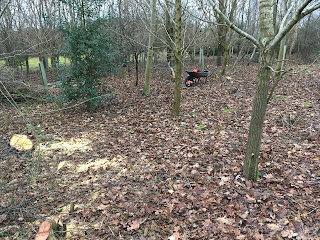Coppicing involves cutting the hazel about 6 inches off the ground to form a stool in which each stem is cut at 45 degrees facing outwards, so that water runs away and does not rot the stump.
Last autumn I put woodland flower seed into the area that I was planning to cut this winter - to give them maximum light in the newly-cut area next spring. So it will be interesting to see if this establishes the plants for next summer, as putting seeds into shady woodland is not that successful.
Last autumn I put woodland flower seed into the area that I was planning to cut this winter - to give them maximum light in the newly-cut area next spring. So it will be interesting to see if this establishes the plants for next summer, as putting seeds into shady woodland is not that successful.
 |
| Coppicing in progress (Compartment 1) |
After 1 year (compartment 2) the shoots are about 5 or 6 feet tall.
 |
| Coppice 1 year after cutting (Compartment 2) |
After 2 years the growth is 10 to 12 feet tall and the ideal height for a great habitat for insects and birds. There are going to be 8 compartments so this area will grow for another 6 years before being cut again.
 |
| Coppice 2 years after cutting (Compartment 1) |
As well as coppicing I am cutting down about half of the silver birches that have been acting as the 'nursery trees', growing fast and tall which gives protection to the rest of the trees. Taking out these tall silver birch trees will enable the slower growing oak, ash and beech to have more light and space (as well as providing me with heating for next winter!). I am keeping half of the silver birch as they provide shape when looking at the woodland and give a variety of habitats - there seem to be a lot of nests in the silver birch branches, where the twins seem denser than in many of the other trees.
No comments:
Post a Comment